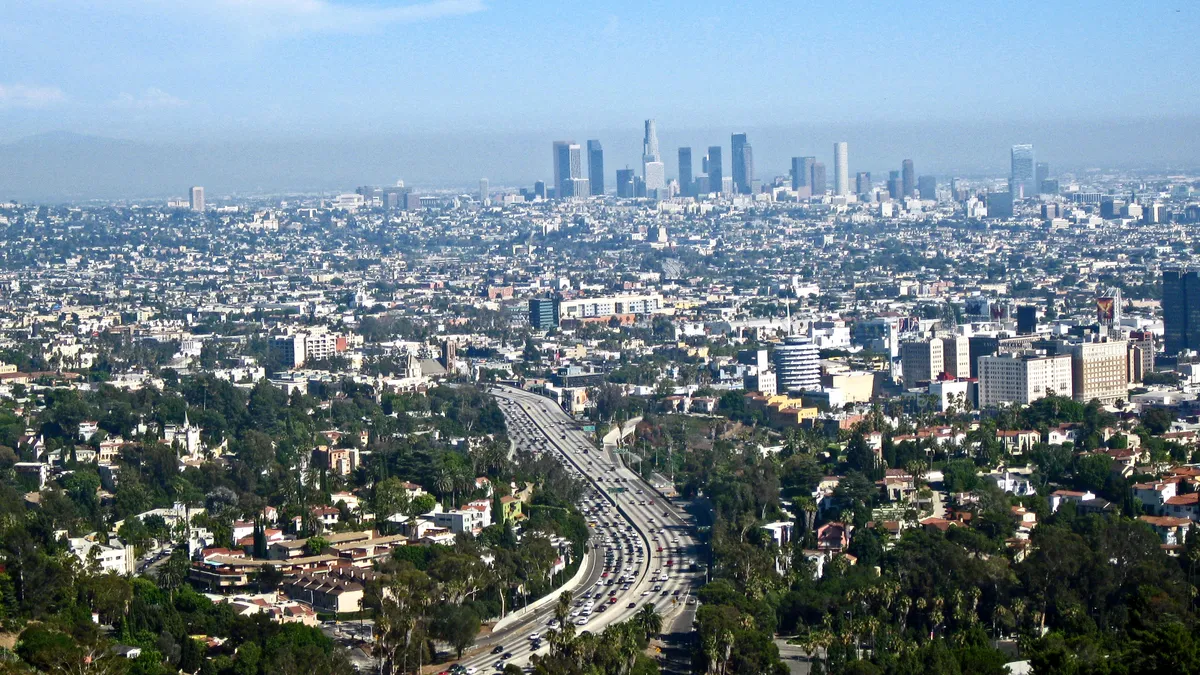UPDATE: The San Francisco Board of Supervisors voted 8-3 to support a resolution that officially opposes Senate Bill 827, according to the San Francisco Examiner. The vote comes just one week after Los Angeles voted unanimously to oppose the bill.
The move is interesting considering Senator Scott Wiener, who proposed the controversial bill that would allow four- to eight-story buildings near transit stops, represents San Francisco. Despite the city's tie to Senator Wiener, city officials found the bill to be "far too overreaching," and many officials hope the opposition from San Francisco and Los Angeles will encourage other mid- to large-size California cities to speak out.
The Examiner reports that Wiener was critical of the vote, calling it a "knee jerk opposition position against a bill allowing more housing near public transportation." Though he indicated that he hopes to collaborate with San Francisco and other cities on the bill.
Dive Brief:
- The Los Angeles City Council unanimously passed a resolution opposing state Senate Bill 827, which proposes adding housing density near public transit stops throughout California.
- If passed, the bill would allow four- to eight-story buildings near transit stops, and it would overrule any existing municipal zoning restrictions on such multi-family residences. The bill is intended to lessen the state's housing crisis by increasing housing supply and thus lowering costs, in addition to easing traffic congestion and improving the environment by positioning more residents near, and encouraging them to take, public transit.
- Los Angeles is the largest California city to officially oppose the measure, although the bill has been contentious since its introduction in January. A number of smaller cities have sent letters of opposition.
Dive Insight:
Few housing experts currently argue that California is not in a housing crisis, or that nothing needs to be done to prevent capacity from further shrinking and costs from climbing higher. However, many people claim that this bill is not the answer.
Los Angeles leaders raised concerns about this measure's potential to disproportionately affect low-income and underserved portions of the community. For example, South Los Angeles has a dense bus network and per the state bill, developers would be allowed to put up denser, taller multi-family housing units. But the inclination could be for developers to buy up cheap land in economically depressed areas to build new establishments, and then construct high-end residences that out-price current members of the community.
City leaders are particularly worried about the potential for high rates of resident displacement. The bill does contain language offering existing residents "right to remain guarantees" for comparable units in the new transit-rich housing developments, but in reality, the new units might not end up being "comparable" to the previous housing on a long-term basis. Existing residents, especially those in rent-controlled buildings, might have no choice but to seek cheaper housing in other neighborhoods. This phenomenon also would technically go against the initial intent of the bill, which is to lower housing costs and create more affordable units.
Building high-density residences in areas that have high rates of poverty and crime has proven unsuccessful in revitalizing neighborhoods, and in fact can worsen existing problems. The former Cabrini-Green high-rise public housing project in Chicago — which at one time housed about 15,000 people — provides an often-referenced example of why planners now steer away from high-density, high-rise housing in low-income neighborhoods. It became a nest of crime, even becoming known for people on the street being shot sniper-style from shooters in the high-rises.
Another pressing concern for leaders in many California municipalities is the bill's ability to override local zoning and design controls. Cities and towns would lose their ability to develop housing solutions that work best for the individual communities, in favor of a one-size-fits-all statewide plan. The bill would more directly affect mid-sized and large cities that have a robust transit network. So what works for San Francisco in Northern California might not work for Los Angeles in Southern California. San Francisco has transit in nearly every neighborhood and the changes would allow high-rise buildings to be constructed in almost every single part of the city, as opposed to just a few neighborhoods as in other cities.
Despite the loud criticism, some proponents of the bill think it will create the additional housing capacity that California so desperately needs, but that current single-family and low-density zoning laws currently prohibit. Some supporters, including some of the candidates for governor, only partially back the bill, indicating that it is well-intentioned but has room for improvement, especially in collecting public feedback about regulations that could drastically change the face of neighborhoods throughout the state.












